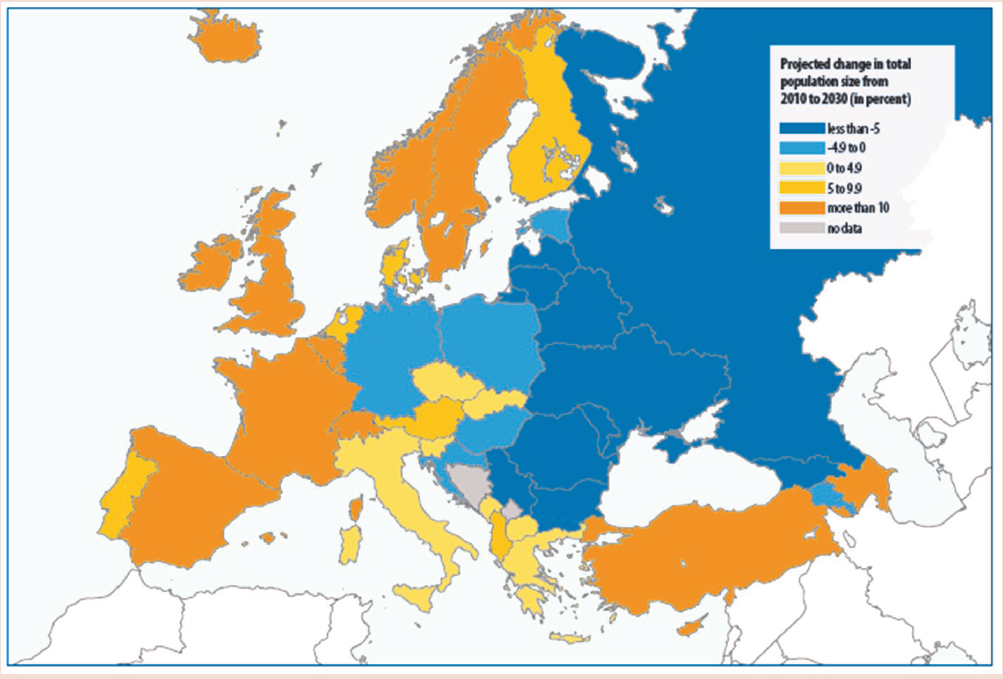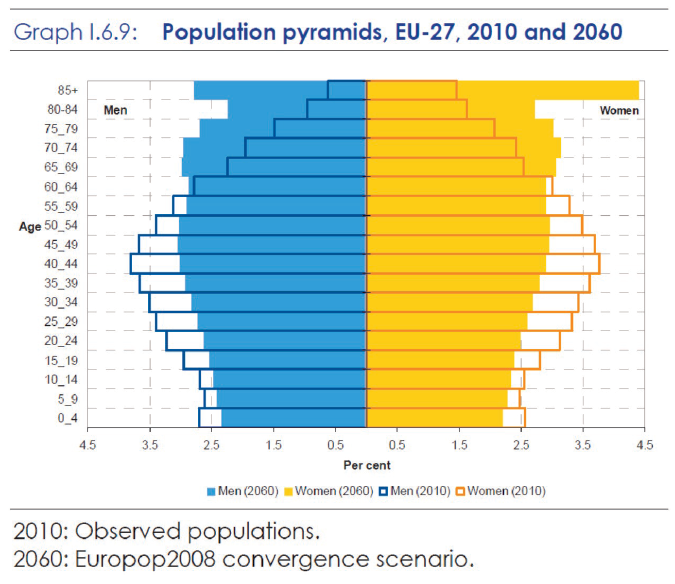European Population 2010-60: Looking at the Demographic Pyramid
Population experts predict that in fifty years’ time the European population is going to look very different to that of today. Over the next fifty years the number of 20 to 49 year olds, males and females, will decline dramatically, by approximately 40-60 million.
Simultaneously, the number of people over 65 years old will increase by approximately 60 million. Churches and mission agencies that concentrate on reaching 20 to 49 year olds (as, for example, with new and emerging forms of church) will find that their ‘religious marketplace’ changes unrecognisably in the next fifty years. They will find that they are competing for a dwindling number of potential new members and this is only likely to continue to fuel the apparently unstoppable need for renewal and innovation of the church experience.
Training Colleges and mission agencies that recruit from among these age groups need to begin thinking carefully about the future of their already stretched institutes. At the same time, those Churches and mission agencies that fail to take the spiritual needs into account (including the need for personal faith in Christ) of the over 65 year olds will be failing in their responsibility to understand the changing nature of the harvest fields that will, indeed, become truly ‘white’! Increasingly it may also be this age group that becomes the focus for mobilisation and support.
Thinking ahead by fifty years is probably beyond the interest of most individuals but it ought to be within the competence of Christian organisations that have already been around for fifty years and which plan to be around for some time to come. The lighter and flexible, so-called church and mission ‘movements’ may argue that the future will not be theirs – they are unlikely to want to be around in fifty years’ time. Their mission and ministry concerns lie in the ‘here and now’. However, a note of caution is advisable: the majority of these changes will begin to take effect by 2020 at the latest.
Whilst many implications of the changing age structure of the European population will remain unclear for many years to come, some of them are more obvious and should inform Christian thinking about the future European population and the contextual challenges it will present to the churches in the years leading up to 2060.
Currently, 40-44 year old males and females are the most common age group in Europe. In 2060, projections show a dramatic flattening out of the age structure (or ‘pyramid’). In 2060, 40-44 year old males will be almost equally matched in number by 65-69 and 70-74 year olds. For females, the contrast will be even more dramatic. In 2060 there will be more women aged 85 and over than any other five year cohort of women, closely followed by 65-79 year old women. Most of this change is projected to occur between 2020 and 2040. Currently, Germany and Italy have the highest percentages of those aged 65+ (20.7% and 20.2% respectively). Conversely, Germany has the lowest number of 0-19 year olds. Ireland has 27.9% under 19 year olds and the lowest number of those aged over 65 (11.3%).
Data relating to the grant of citizenship to non-EU students in 2009 suggests that if emerging, planned, fresh, and simple forms of church are targeted at 20-50 year olds, then especially between 2020 and 2040, such initiatives should be taking a much closer look at mission with and among migrants in Europe. This is the most likely age of a newly arrived migrant in Europe. This poses some fascinating questions about the impact of increasing numbers of migrants upon Europe’s churches.
What scenarios can we imagine for the European church of the (not too distant) future? An elderly indigenous European church population that is trying to understand itself in relationship to a younger migrant church population will find itself faced with a number of options. Issues of power, vitality of faith, representation, and of ethnicity are not about to go away in a hurry. Future scenarios like this can generate both fear and optimism. Above all, we must pray for a response of faith that continues to imagine the transformation of the churches in Europe and of the communities which they are called to serve in the name of Christ, the ‘I am’.
Darrell Jackson



